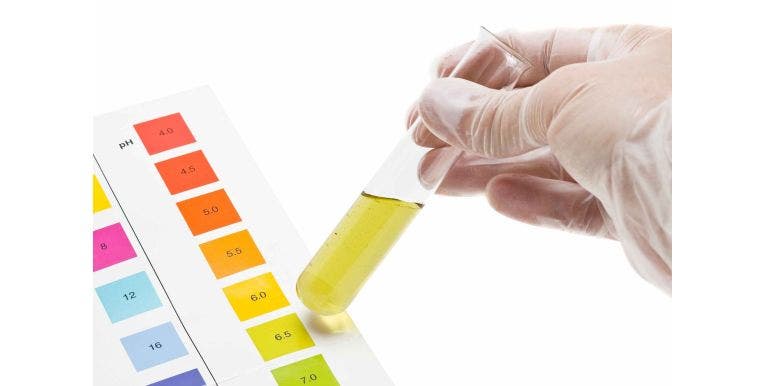How Does Temperature Affect pH?
As the temperature rises, molecular vibrations increase, resulting in water's ability to ionize and form more hydrogen ions. The dissociation of water into hydroxide ions and hydrogen can be represented as
H2O (l) ⇌ H+ (aq) + OH− (aq)
Every solution will change its pH value through temperature changes. A difference in pH measurements at different temperatures is NOT an error! The new pH level simply tells about the true pH for that solution at that specific temperature.
The value of Kw (Water ionization constant) and pH with increasing temperature


It is clearly evident from the table that the pH of water at 0oC is 7.47, but the same water at 100oC will have a pH of 6.14*.
Typical pH values for solutions at different temperatures


From the table, we can conclude that the effect of temperature is greatest for highly basic solutions.
What is the Common Oversight with pH Testing?
A common oversight is when you take a sample from a process tank and make the pH measurement in the laboratory. At that time, you are probably not measuring pH at the same temperature as the temperature in the process tank, this means that you will not have the correct pH value for the sample. Thus a pH value without a temperature value is meaningless. This can be simply overcome by testing pH on-site and at the source of the sample.
Using Le Chaterlier’s Principle
According to Le Chatelier's principle, when changes are made to a chemical system in a state of equilibrium, the system responds by shifting the equilibrium to counteract the changes. Temperature is one of the factors that can cause such changes in a chemical system, affecting its equilibrium state and pH level. An increase in temperature causes the system's equilibrium to shift, absorbing the excess heat and leading to the formation of H+ ions, which results in a decrease in the solution's pH.
This phenomenon can be explained by the principles of thermodynamics and chemical kinetics, and its effects on pH are of great importance in various fields of science, including chemistry, biology, and environmental science.
The dissociation of ions, when heat is increased inside a solution, is displayed in the equation below:
H20 (L) = H+ (aq) + OH- (aq)
Are pH & Acidity the Same?
There is often a misconception regarding the correlation between pH and acidity. It should be noted that a decrease in pH, which is induced by an increase in temperature, does not necessarily mean that the solution's water has become more acidic.
The acidity of a solution is determined by the concentration of hydrogen ions in relation to hydroxide ions. For instance, in the case of purified water, the concentration of these ions remains constant. Hence the pH of pure water is always neutral, with a value of 7.0 at room temperature.
However, if the temperature of the water increases by 167°F, the pH value will decrease to 6.14, despite the solution remaining neutral on the pH scale. This significant decrease in pH may lead to incorrect assumptions about the sample's chemical properties. Therefore, it is crucial to understand the relationship between temperature, pH, and acidity to prevent such errors.
How Does Temperature Affect pH Readings?
The effects of temperature can be divided into two main categories:
- Temperature effects on the accuracy and speed of response of a pH electrode
- The temperature Coefficient of the solution (either buffer or sample) being measured by the pH sensor
Types of Temperature Compensation
There are two common types of temperature compensation when working with pH measurements.
- Automatic Temperature Compensation (ATC) compensates for the fluctuating milli-volt output from the electrode. ATC is commonly built into today’s pH meters for quick and accurate results.
- Solution Temperature Compensation (STC) (whether this is needed will depend on the pH accuracy required) converts the pH at the measurement temperature to the pH at a reference temperature. The reference temperature is generally 25°C. Only pH values taken at the same temperature or converted using solution temperature compensation can be compared to each other.
Remember that the solution temperature effect and electrode temperature effect are different. To get your best results in pH measurement, always remember to calibrate and measure at the same temperature.
How To Prevent Temperature-Related Errors When Testing pH?
To prevent errors in pH readings caused by temperature fluctuations, using a pH sensor equipped with automatic temperature compensation (ATC) system is highly recommended. If such a system is not present in the pH sensor, the temperature of the sample must be measured and compensated for during pH measurements. Utilizing pH litmus paper test kits is not advisable in this regard, as they need the capability to adjust for potential temperature changes. Furthermore, measuring samples in a controlled water bath can help compensate for temperature fluctuations by placing both the buffer solutions and the sample being tested inside the water bath.
Summary
The pH value of a solution is directly dependent on the temperature.
- A pH value without a temperature value is incoherent.
- Solution temperature compensation (STC) converts the measured pH to the pH at 25°C.
- pH values taken at the same temperature or converted using solution temperature compensation can be compared to each other.
- To achieve the highest accuracy, calibrate and measure at the same temperature.
FAQs
How are enzymes affected by temperature and ph?
Enzyme activity is significantly influenced by temperature and pH levels. Optimal conditions vary for different enzymes. Higher temperatures generally increase activity but may cause denaturation beyond the optimal point. pH levels affect enzyme structure and substrate binding; deviations from the optimal pH can reduce activity or cause inactivation.
How does pH and temperature affect enzyme activity?
Temperature and pH affect enzyme activity by altering their structure and substrate binding. Each enzyme has an optimal temperature and pH for maximum efficiency. Deviations from these optimal conditions can lead to reduced activity, inactivation, or denaturation of the enzyme.


